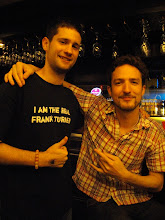With financial fallout and embargoes, which resulted in economic nationalism, to blame for the radicalization and birth of W.W. II in Europe and Asia, and the European and Asian economies and markets completely nonfunctional by the end of the war, the United States economy began emerging as the dominant player. The table was set for the United States to begin rebuilding Europe and Asia in its interest:
The reparations deal we make with Russia and the money and materials we invest in Germany will set new trade patterns for Europe. The old pattern was fear, hate, nationalism. Said Danton, "One destroys only what one replaces." Europe's old pattern must be replaced, and it is within the power of American leadership to do it (Life, 1947).
The United States would need to replace nationalism - and the protectionism that comes with it - with something new, or the risk was what wasn't replaced would come back. America answered the challenge:
The onlookers now fear that the No. 1 nation may relapse into her old place in the old pattern, thus dooming them to do the same. For example, they fear (especially many Britons) that callow, ungovernable America is heading for another depression. But the State Department has for years been committing itself to a policy which would remove the known international causes of the great prewar depression and which if successful would so change the prewar pattern of nationalism and poverty as to make these apprehensions irrelevant. This policy is freer world trade…For the whole hope of new U.S. prosperity depends on a much broader trading area (Life, 1947).
The United States had declared that the way to peace was freer world trade. What needed to be replaced was protectionism and its many dangers and it would be replaced by free-trade. But weren't capitalist systems in place in Europe prior to WW II?
One big mistake of international capitalism was its failure to share – not its products, which went everywhere – but its systems. The ownership of capital plant was too confined to a few countries, while the so-called backward countries supplied only raw materials, like so many captive farms (Life, 1947).
This was the evolution of modern capitalism. It was undergoing a transformation in Europe from partial openness to the system the United States would model after its own ideologies and interests: A free-trade, democratic economy. This new system would need several things.
First:
An open international economic system requires an absence of geopolitical turbulence in vital core regions; the existence of stable governments that will keep domestic economies open to foreign trade and investment; secure trade routes; and access to – and stability in – the peripheries. (Layne, The Peace of Illusions: American Grand Strategy from 1940 to the Present, 2006)
Second, as Walt Rostow and Max Milliken put it:
"We have, in short, a major and persistent stake in a world environment predominantly made up of open societies; for with modern communications it is difficult to envisage the survival of a democratic American society as an island in a totalitarian sea." (Layne, The Peace of Illusions: American Grand Strategy from 1940 to the Present, 2006)
Third:
U.S. policy makers are concerned especially about preventing the consequences of re-nationalizations…U.S. forces are in Europe and East Asia to prevent the kind of "security vacuums" that could lead to re-nationalization…In plain English, U.S. policymakers fear that key regions will lapse back into multipolar instability that could affect U.S. Open Door economic interests…Re-nationalization is the code word U.S. strategists use to denote a reversion to multipolarity. Because they believe multipolarity is inherently destabilizing – and hence inimical to economic openness"… And a "re-nationalized" Western Europe – one beset with political rivalries and security competitions – would have been an inhospitable environment for the economic Open Door…As Deputy Secretary of State Strobe Talbott declared, "The well-being of the United States depends in large measure on what happens in Europe – the U.S. will not prosper without an economically vibrant Europe; the U.S. will not be safe without a secure and peaceful Europe." (Layne, The Peace of Illusions: American Grand Strategy from 1940 to the Present, 2006)
And finally:
America's liberal ideology holds that political and economic Open Doors cause peace and stability. (Layne, The Peace of Illusions: American Grand Strategy from 1940 to the Present, 2006)
So to sum up, the economic system the United States would attempt to form and try to maintain was to keep geopolitical turbulence out of core regions, maintain governments friendly to free-trade, an absolute necessity that Liberalism friendly states succeed, prevention of re-nationalization and multipolarity in Europe and Asia. The belief was if this ideology is followed, it will cause peace and stability.
So how does this tie into national security?
Liberal ideology postulates that to be secure the United States must continue to expand until it has established an Open Door world by replicating its liberal institutions and values abroad. Thanks to liberalism, there is "a potentially limitless dimension" to the American conception of "national" security. (Layne, 2006)
In short, any threat to the stability of free-trade, any government that is closed to trade or interdependency, states that begin taking on more nationalistic and protectionist tones, any rising military powers that would create re-armament in European and Asian countries will cause instability and could lead to war – and that is not in the interest of the United States or its national security.

No comments:
Post a Comment